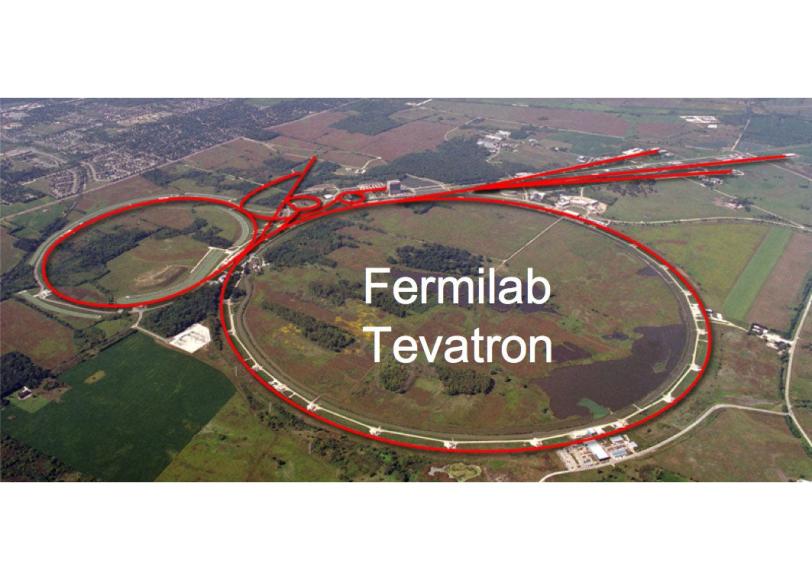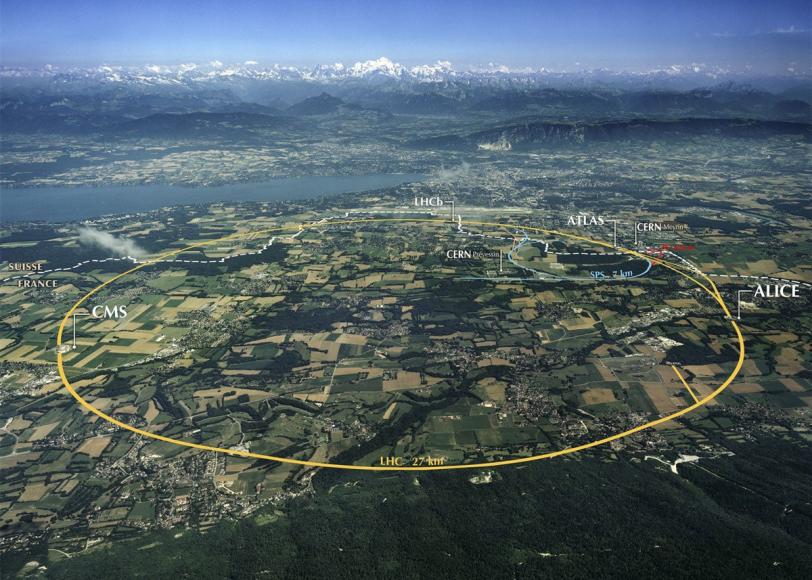Mysterious Asymmetry Puts SLAC Theorists on the Trail of Possible New Particle
As they say in the movie business, here's the pitch: tantalizing hints of an interaction that could demonstrate the existence of a new subatomic particle have emerged during the last months of operation of a venerable particle accelerator (the Tevatron at Fermi National Accelerator Laboratory, playing itself).
By Lori Ann White
As they say in the movie business, here's the pitch: tantalizing hints of an interaction that could demonstrate the existence of a new subatomic particle have emerged during the last months of operation of a venerable particle accelerator (the Tevatron at Fermi National Accelerator Laboratory, playing itself). Meanwhile, thousands of miles away, a second, more powerful accelerator has just come online (the Large Hadron Collider, appearing courtesy of CERN). The LHC is seemingly powerful enough to confirm or disprove the Tevatron results but, due largely to the fact the Tevatron collides protons with anti-protons while the LHC smashes proton against proton, the prospects for the LHC to uncover the same evidence are slim.
Can a small, intrepid band of theoretical physicists find a way to capture this fleeting interaction in the LHC's post-collision stew of jets and particle trails? The fate of the Standard Model of particle behavior hangs in the balance...
It almost sounds like the plot of a sci-fi thriller, but this drama has actually been playing out in the world of high-energy physics. Recent results from the Tevatron seem to suggest that some top quarks created at the Tevatron collision points, where a beam of protons from one direction meets an opposing beam of anti-protons, have some odd characteristics. They behave as though, in general, they prefer to speed away from the collisions in one particular direction, instead of spraying out symmetrically.
The Standard Model—currently the most complete description of how matter interacts to make stars, planets, people and everything in the universe—predicts the resulting shower of particles to scatter almost equally in the directions of both beams. Instead, the top quarks seem biased, with a larger-than-expected number of them zinging away from the collision in the direction of the incoming protons. The Standard Model doesn't include behavior like that. If the Tevatron results hold, they show that something new has been written into the script; that "something" is most likely a massive particle not currently included in the Standard Model cast of characters.
That's a big if. The two experiments at the Tevatron, CDF and DZero, have both reported this odd preference of top quarks as "a small discrepancy" in their data, explained SLAC theoretical physicist JoAnne Hewett, leader of one small, intrepid band of theoretical physicists searching for an explanation. "They've seen this discrepancy for a while now, and as they've accumulated data the discrepancy has persisted." But demonstrating the existence of any new phenomenon in particle physics is a numbers game, and the "small discrepancy" has thus far not been seen in sufficient numbers for the two collaborations to convincingly make their case.
"How many quarks and gluons you get out of slamming particles together depends on the energy of the collider," Hewett explained. The LHC is much more powerful than the Tevatron—7 TeV in its first few years of operation, with a final expected power of 14 TeV, compared to the Tevatron at just less than 2 TeV. This should provide more top quarks to watch in fewer collisions. In fact, Hewett said, assuming the Tevatron results are real, the LHC could provide enough data to see the source of the discrepancy within months. A happy ending is in sight—then the plot thickens.
In principle, the higher-energy collisions of the LHC should boost the numbers substantially, and the LHC's proton–proton collisions do create substantially more top quarks. But the machine has a difficult time creating these asymmetric top quarks, which are born of the asymmetry between the Tevatron's two beams. The top quarks are created at the Tevatron by smashing a quark from a proton into an anti-quark from an anti-proton. The particles with the biggest probability of colliding at the LHC are all quarks and gluons.
In addition to a lack of anti-quarks, the asymmetry of the result itself works against the LHC. Remember, at the Tevatron, the top quarks are biased toward the proton beam, and away from the anti-proton beam. At the LHC there are two proton beams, and therefore no obvious bias.
Meanwhile the Tevatron is running out of time. The nearly 30-year-old atom smasher, which spent most of its years as the most powerful collider in the world—and the only one capable of making top quarks with enough frequency to prove they actually exist—is scheduled to shut down at the end of September.
Enter Hewett and her co-authors.
"The idea for the analysis started in a workshop last June," Hewett explained. "CDF and DZero had this discrepancy, and we were wondering what the LHC could do. The folklore at the time was that the LHC couldn't do anything." However, as Hewett put it, "The asymmetry at the LHC is very, very subtle. Not non-existent."
Hewett and her co-authors examined the many ways top quarks can be created (the quarks in question appear as part of quark/anti-quark pairs), and determined a way to "boost the signal" of the top quarks by identifying what data physicists at the LHC should look at. By devising techniques to hone in on the regions in the data where the top quarks are most likely to be asymmetrically produced, researchers at the LHC have a much better chance of observing the asymmetry.
Though the paper presenting their conclusions has not yet been published in a journal—it's posted to the widely-read physics ArXiv (pronounced "archive"), which includes pre-publication results—the work is already cited by other researchers and getting interest from the press, Hewett said.
Another twist in the plot that's keeping Hewett on the edge of her seat is that the LHC is powerful enough to reveal the possible new particles directly, instead of through fleeting interactions that send top quarks zipping off in odd directions. Of course, the wayward tops may still prove useful until physicists know how to identify the new particle in a sea of LHC data, but Hewett is hard at work on that score, too.
"We can take the mass and coupling strength [two fundamental properties of subatomic particles] the particle has to have to do what it does, and work back to what it must be," Hewett said. Her thought? Something called an axigluon, akin to the gluons that hold quarks together. But in truth, "I don't know," Hewett said. "Maybe it's not even a new particle. But that's what's fun."
Whether the elusive particle is tracked down using top quarks or more direct evidence, it's clear the climax of the story is fast approaching. Hewett said she thinks the LHC will have enough data by the end of summer.
Related Links
- $A^t_{FB}$ Meets LHC, JoAnne Hewett, Jessie Shelton, Michael Spannowsky, Tim Tait, Michihisa Takeuchi, arXiv:1103.4618v2


